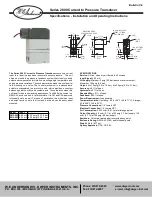
TM-D710A/D710E
5
3-5. TNC Section
The reception data signal from the main unit is input
to the panel section through the PRI terminal (pin 8 of the
modular jack of the panel section). This signal is the same
as the PR9 signal of the DATA terminal. So, the data signal
enters the panel section through the same route for both
1200bps and 9600bps.
The reception data signal from the PRI terminal passes
the LPF (gain: 0, cutoff frequency: 4.8kHz) of IC22, adjusts
the output with the electric volume (IC20) and the data
signal enters the operational amplifier (IC10). The output
adjustment value of the electric volume is fi xed. The data
signal of 1200bps and 9600bps is divided with the op-
amp (IC10). Each data signal passes the buffer amp and is
converted to a logic signal by the comparator (IC17).
The logic signal converted with the comparator enters
to the TNC ASIC (IC12). The signal is demodulated with the
TNC ASIC and is then processed with the TNC MPU (IC11).
For packet mode, signals processed with the TNC MPU
enter to the panel MPU. The digital signals are not changed
in the panel MPU. The level of the signal is changed with
the RS-232C driver IC (IC7) and the signals are then output
from the COM terminal (J2).
In APRS mode, the signal entering the panel MPU is
processed and the status is displayed on the LCD.
The TNC section uses the same 3-chip TNC as the
TM-D700. The flash-type TNC MPU is used and the
firmware can be rewritten. The MPU clock operates at
double frequency. TNC ASIC is an existing product. So, the
frequency of the clock signal is divided by half with the fl ip-
fl op (IC16).
T h e S - R A M ( I C 1 3 ) h a s a c a p a c i t y o f 4 M b i t s i n
order to operate smoothly in the KISS mode of packet
communication.
CIRCUIT DESCRIPTION
3-2. Key, Encoder, Volume Input Circuit
The panel section key corresponds to the panel
MPU port, one-to-one. The POWER key is pulled up and
connected to the interrupt port of the panel MPU.
Other keys are also pulled up outside because the panel
MPU is an 8 bit data bus mode. The scanning process reads
out the status of the keys. So, if a key is in the ”L” level, no
other keys are accepted.
The encoder is connected to the panel MPU and the port
is pulled up.
The volume (VOL/SQL) divides the 5V voltage, reads
with the A/D port of the panel MPU and transfers the data
to the main unit section MPU (IC918).
3-3. Display Circuit
The LCD is a COF (Chip On Flexible printed circuit
board) type with the driver IC mounted on the FPC and
controlled by the 8 bit data bus mode. The voltage ”V3”
is approximately 12V for the LCD, but due to the voltage
booster function of this driver IC, it can operate with a single
power of 5V.
The contrast can change this ”V3” voltage by 16 steps,
using the internal memory of the driver IC.
3-4. Brightness Circuit
The illumination color can be set to either amber or
green.
The PWM signal output from the panel MPU passes
through the LPF, is converted into DC voltage, and controls
the current that fl ows to the LED with the transistor. The
duty of the PWM changes the LED brightness to one of
eight levels or OFF.
AMBER
GREEN
Current
control
IC1
Panel
MPU
Q5
Q4
SW
LPF
PWM
10V
Current
control
Q7
Q6
SW
LPF
PWM
10V
Fig. 2 Brightness circuit






































